|
|
|
INGWALD MOE RESIDENCE,
GARY, INDIANA (1905/1908-9 - FLLW #0531) |
|
|
|
|
SANBORN MAPS 1908/1911
PRESENTATION DRAWING 1909
REDISCOVERED 1996 MOE 2023
ADDITIONAL WRIGHT STUDIES |
|
|
|
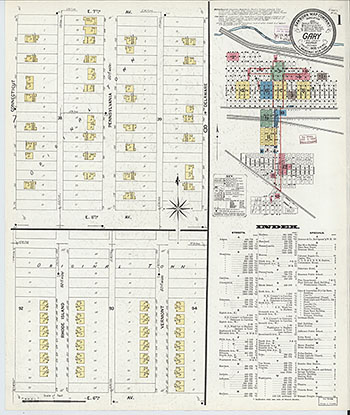 |
Date:
1908
Title:
1) Ingwald Moe Residence, Gary, Indiana, Map 1908 (1909 - FLLW
#0531).
Description: The Sanborn Fire Insurance Map for
the City of Gary, Indiana, published in December, 1908 shows a
vacant lot on the Northeast corner of 7th and Van Buren Street.
The Moe House was built on the Southwest corner of Block 53.
Sanborn Maps published in January 1911 includes the footprint of
a two-story house with a one-story partially covered porch.
Published December, 1908 by the Sanborn Map Company, New York.
Sheet 1 of 12 sheets. By comparing the map published in
December, 1908 to the map published in January 1911, it confirms
that the Ingwald Moe house was constructed during 1909-1910. The
Inwald Moe House was designed by Frank Lloyd Wright in
1905/1908-9, and most likely plans from the Evanston Model
Housing Project. Courtesy of the Library of Congress.
See Additional Details...
Size:
8 x 9.5 Color photograph
S#:
0085.56.1123 |
|
|
|
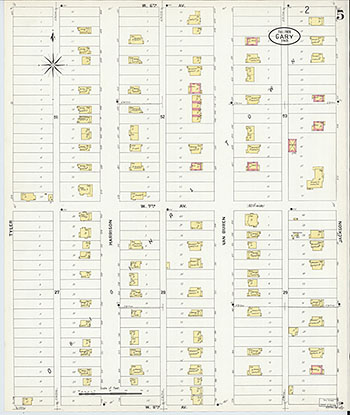 |
Date:
1908
Title:
2) Ingwald Moe Residence, Gary, Indiana, Map 1908 (1909 - FLLW
#0531).
Description: The Sanborn Fire Insurance Map for
the City of Gary, Indiana, published in December, 1908 shows a
vacant lot on the Northeast corner of 7th and Van Buren Street.
The Moe House was built on the Southwest corner of Block 53.
Sanborn Maps published in January 1911 includes the footprint of
a two-story house with a one-story partially covered porch.
Published December, 1908 by the Sanborn Map Company, New York.
Sheet 5 of 12 sheets. By comparing the map published in
December, 1908 to the map published in January 1911, it confirms
that the Ingwald Moe house was constructed during 1909-1910. The
Inwald Moe House was designed by Frank Lloyd Wright in
1905/1908-9, and most likely plans from the Evanston Model
Housing Project. Courtesy of the Library of Congress.
See Additional Details...
Size:
8 x 9.5 Color photograph.
S#:
0085.57.1123 |
|
|
|
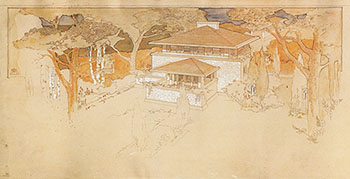 |
Date:
1909
Title:
Ingwald Moe Residence, Gary, Indiana,
Perspective Drawing 1909 (1909 - FLLW #0531).
Description: Perspective
presentation drawing of the Moe Residence by Marion Mahony.
Designed by Frank Lloyd Wright in 1905/1908-9, and most likely
plans from the Evanston Model Housing Project. The exterior
walls of the house are covered in plaster and extends up to the
roof line. When this drawing was rediscovered, it was initially
credited to be the Charles Brown House because of the
similarity. It was nearly a complete match. Christopher Meyers
writes: “In the summer of 1996, I had the pleasure to confirm a
perspective drawing from the business portfolio of Marion Mahony
as the Moe residence... The drawing was originally accredited to
be the Charles Brown House. Mahony's perspective denotes a
stucco structure on a large corner lot. The Charles Brown House
is not on a corner lot rather it is located mid-block and
possesses a wooden board and batten first floor. Rather Mahony's
rendering illustrates the Moe residence, on the corner of 7th
and Van Buren, possessing a hipped roof, broad projecting eaves,
inset banding, double hung art glass windows, a front veranda
with a cantilevered roof, and as being amply landscaped...”
Christopher Meyers continues, “669 Van Buren is a precise
realization of what Frank LLoyd Wright originally designed for
the 1905 Charles Brown residence, located in Evanston, Illinois.
The Moe and Brown houses are identical, both having matching
scale, massing, and floor layouts. The Moe House differs in that
its first floor possesses an exterior stucco application in
comparison to the Brown House having wooden board and batten
clapboard.” We might add that even the art glass windows and
doors match the Brown Residence designed by Frank Lloyd Wright.
Marion Mahony’s monogram can be seen on the far left. This
illustration is published on the cover of Frank Lloyd Wright &
Colleagues: Indiana Works, Stodola, 1999. Also published in
Frank Lloyd Wright, Complete Works, 1885-1916, Pfeiffer, 2011,
but is incorrectly flipped horizontally. Courtesy of the Frank
Lloys Wright Foundation.
See Additional Details...
Size:
Copy 10 x 5 Color
photograph.
S#:
0086.34.1123 |
|
|
|
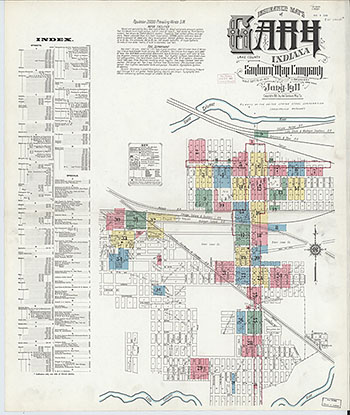 |
Date:
1911
Title:
3) Ingwald Moe Residence, Gary, Indiana, Map 1911 (1909 - FLLW
#0531).
Description: The Sanborn Fire Insurance Map for
the City of Gary, Indiana, published in January, 1911 shows a
house on the Northeast corner of 7th and Van Buren Street. The
Moe House was built on the Southwest corner of Block 53. Sanborn
Maps published in January 1911 includes the footprint of a
two-story house with a one-story partially covered porch. The
roof was slate or tin and indicates framed construction,
plastered finish. A one-story plastered Auto House was built on
the Northeast corner of the lot. The property was a corner lot
that combined three lots. Published Janury, 1911 by the Sanborn
Map Company, New York. Sheet 1 of 34 sheets. By comparing the
map published in December, 1908 to the map published in January
1911, it confirms that the Ingwald Moe house was constructed
during 1909-1910. The Inwald Moe House was designed by Frank
Lloyd Wright in 1905/1908-9, and most likely plans from the
Evanston Model Housing Project. Courtesy of the Library of
Congress. See Additional Details...
Size:
8 x 9.5 Color photograph.
S#:
0104.40.1123 |
|
|
|
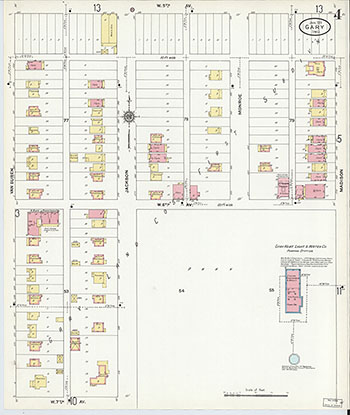 |
Date:
1911
Title:
4) Ingwald Moe Residence, Gary, Indiana, Map 1911 (1909 - FLLW
#0531).
Description: The Sanborn Fire Insurance
Map for the City of Gary, Indiana, published in January, 1911
shows a house on the Northeast corner of 7th and Van Buren
Street. The Moe House was built on the Southwest corner of Block
53. Sanborn Maps published in January 1911 includes the
footprint of a two-story house with a one-story partially
covered porch. The roof was slate or tin and indicates framed
construction, plastered finish. A one-story plastered Auto House
was built on the Northeast corner of the lot. The property was a
corner lot that combined three lots. Published Janury, 1911 by
the Sanborn Map Company, New York. Sheet 4 of 34 sheets. By
comparing the map published in December, 1908 to the map
published in January 1911, it confirms that the Ingwald Moe
house was constructed during 1909-1910. The Inwald Moe House was
designed by Frank Lloyd Wright in 1905/1908-9, and most likely
plans from the Evanston Model Housing Project. Courtesy of the
Library of Congress. See Additional
Details...
Size:
8 x 9.5 Color photograph.
S#:
0104.41.1123 |
|
|
|
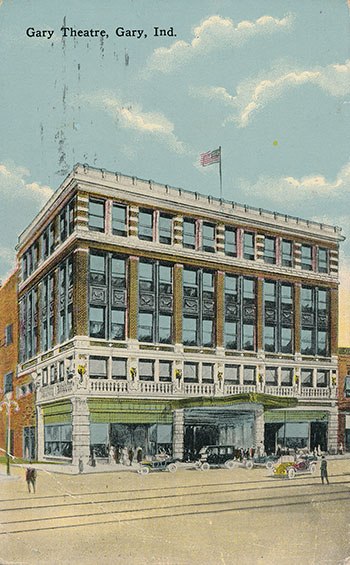 |
Date:
Circa 1915
Title:
Ingwald Moe Residence, Gary, Indiana, Moe (Gary) Theater
Postcard Circa 1915 (1909 - FLLW #0531).
Description:
Postcard of the Moe (Gary) Theater in Gary Indiana. Ingwald Moe
was a Norwegian immigrant and contractor with offices in
Chicago. In 1897 he married Louisa Schaible of Ann Arbor,
Michigan. They had three children. In 1898 they moved to Gary,
Indiana. Moe saw an opportunity in the expanding steel economy.
He opened an office on Broadway in Gary. According to Jane
Morocco, "Moe played an important role in developing the city of
Gary. He was one of the founders of the Gary Commercial Club and
the chamber of commerce, and also had a major role in the
planning and building of the Gary Gateway. He erected some of
the community's largest buildings, including the bathing
pavilion at Marquette Park, Gary Theater, Post-Tribune Building,
Methodist Hospital, and city hall. He was also proprietor of
Gary's first motion picture theater, located at 766 Broadway. In
1922, under his guidance, construction of Route 12, also known
as Dunes Highway, began." Trailside Museum: The Legend of
Virginia Moe, 2015. The Gary Theater opened in 1913, at the
corner of Broadway and Fifth Avenue. It began as a vaudeville
theater, but over time became a movie theater. It could seat
over 1100 people. Text on Face: “Gary Theatre, Gary Indiana.”
Note: Early postcards dated 1914-16 called it the “Moe Theatre,
Gary Indiana.” Text on verso: “Post Card.” “12143.” Postmarked:
“May 25, 1916.”
Size:
3.5 x 5.5
S#:
0128.71.1123 |
|
|
|
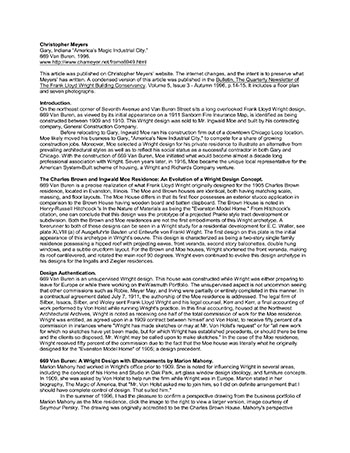 |
Date:
1996
Title:
Ingwald Moe House. Gary, Indiana
“America’s Magic Industrial City.”
669 Van Buren.
Author: Meyers, Christopher
Description:
This article was published on Christopher Meyers’ website. The
internet changes. We felt this article is sinificant and should
be preserved. We attempted to contact Christopher Meyers, but
were unable. Mr. Meyers, please contact us. A condensed version
of this article was published in the
Bulletin, The Quarterly Newsletter of The Frank Lloyd Wright
Building Conservancy. Volume 5, Issue 3 - Autumn 1996,
p.14-15. It includes a floor plan and seven photographs.
Introduction. On the northeast corner of
Seventh Avenue and Van Buren Street sits a long overlooked Frank
Lloyd Wright design. 669 Van Buren, as viewed by its initial
appearance on a 1911 Sanborn Fire Insurance Map, is identified
as being constructed between 1909 and 1910. This Wright design
was sold to Mr. Ingwald Moe and built by his contracting
company, General Construction Company.
Before relocating to Gary, Ingwald Moe ran his construction firm
out of a downtown Chicago Loop location. Moe likely moved his
business to Gary, "America's New Industrial City," to compete
for a share of growing construction jobs. Moreover, Moe selected
a Wright design for his private residence to illustrate an
alternative from prevailing architectural styles as well as to
reflect his social status as a successful contractor in both
Gary and Chicago. With the construction of 669 Van Buren, Moe
initiated what would become almost a decade long professional
association with Wright...
Full Article...
Size:
8.5 x 11
Pages: Pp 2
ST#:
1996.100.1123 |
|
|
|
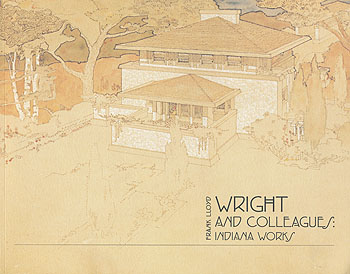 |
Date:
1999
Title:
Frank Lloyd Wright and Colleagues: Indiana Works (Soft Cover)
(Published by the John G. Blank Center for the Arts, Michigan
City, Indiana)
Author: Stodola, Barbara; Monberg,
Gregory H.; Owings, Frank N. Jr. Foreword by Brockway, Lee J.
Description:
An exhibition organized by Barbara Stodola, July 24 - October
24, 1999. At the John G. Blank Center for the Arts, Michigan
City, Indiana. Three essays include: Frank Lloyd Wright and His
Colleagues; Wright's First Step into Indiana - Wolf Lake Resort;
Usonia in Indiana. A section also includes a list of The
Colleagues. "Forward. Frank Lloyd Wright, the most widely
recognized architect of the century, design several buildings in
Indiana and across the state that still bring mixed reactions
from the observing public. Some of us feel that his buildings
are very different from what we are used to seeing and others of
us see his work as the manifestation of his creative design
genius. We have prepared this exhibit to help us all understand
the importance of his design philosophy and to appreciate his
influence on the quality of contemporary home design..."
Note: Cover illustration is the perspective presentation drawing
of the Moe Residence by Marion Mahony. The
Ingwald Moe Redisence was designed
by Frank Lloyd Wright in 1905/1908-9, and most likely were plans
from the Evanston Model Housing Project.
Two copies, one inscribed by Barbara Stodola.
Size:
11 x 9
Pages: Pp 48
ST#:
1999.95.0719, 1999.105.1123 |
|
|
|
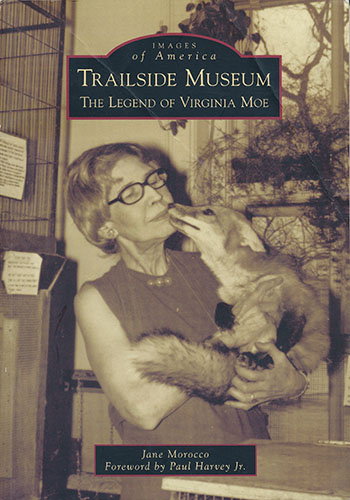 |
Date:
2015
Title:
Trailside Museum. The Legend of Virginia Moe (Soft Cover)
(Published by Arcadia Publishing, Charlston, South Carolina)
Author:
Morocco, Jane
Description:
Virginia Moe dedicated more than 50 years
of her life to Trailside Museum in River Forest, Illinois. She
was the daughter of Ingwald Moe, a Norwegian immigrant and
contractor with offices in Chicago. In 1897 he married Louisa
Schaible of Ann Arbor, Michigan. They had three children, one of
which was Virginia Moe. In 1898 they moved to Gary, Indiana. Moe
saw an opportunity in the expanding steel economy. He opened an
office on Broadway in Gary. According to Jane Morocco, “Moe
played an important role in developing the city of Gary. He was
one of the founders of the Gary Commercial Club and the chamber
of commerce, and also had a major role in the planning and
building of the Gary Gateway. He erected some of the community's
largest buildings, including the bathing pavilion at Marquette
Park, Gary Theater, Post-Tribune Building, Methodist Hospital,
and city hall. He was also proprietor of Gary's first motion
picture theater, located at 766 Broadway. In 1922, under his
guidance, construction of Route 12, also known as Dunes Highway,
began.” Trailside Museum: The Legend of Virginia Moe, 2015,
p.63.
In 1908-09 Ingwald Moe built a Frank Lloyd Wright House.
Includes two portraits of Ingwald Moe, and six photographs of
the Ingwald Moe House. Original list price $21.99. (First
Edition)
Size:
6.5 x 9.25
Pages:
Pp 127
ST#:
2015.46.1123 |
|
|
|
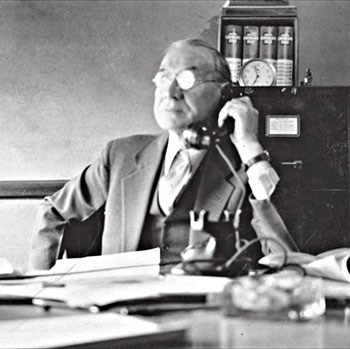 |
Trailside Museum, Page 63. Caption:
In this 1937
photograph, Ingwald Moe works out of his office at 760 Broadway
in Gary. Ingwald Moe played an important role in developing the
city of Gary. He was one of the founders of the Gary Commercial
Club and the chamber of commerce, and also had a major role in
the planning and building of the Gary Gateway. He erected some
of the community's largest buildings, including the bathing
pavilion at Marquette Park, Gary Theater, Post-Tribune Building,
Methodist Hospital, and city hall. He was also proprietor of
Gary's first motion picture theater, located at 766 Broadway.
In 1922, under his guidance, construction of Route 12, also
known as Dunes Highway, began.
Ezra Sensibar, Ingwald Moe's
good friend, was the construction engineer who worked with him
on the project. (Courtesy of Diane Schulz.) |
|
|
|
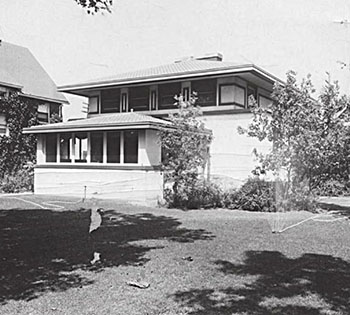 |
Trailside Museum, Page 65. Caption:
During the building of the Moe family home, Frank
Lloyd Wright was away in Europe working on the Wasmuth Edition,
a portfolio of his work. Before he left, he hired Hermann Von
Holst, a Chicago architect, to take charge of his office. On
September 22, 1909, in Oak Park, Wright and Von Holst signed a
detailed contract. Two members of Wright's former staff were
hired by Von Holst, Marion Mahony and Walter Burley Griffin.
(Courtesy of Diane Schulz.).
|
|
|
|
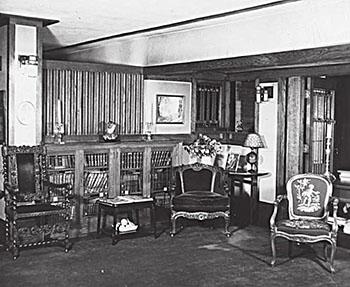 |
Trailside Museum, Page 66. Caption:
When the Moes' home
was completed, Ingwald Moe and family moved in with all their
own furniture, which was mostly Victorian.
During the early
1900s, many of Frank Lloyd Wright's clients would furnish their
newly built Prairie homes in this way, an anachronism that
Wright did not care for. He slowly began to design built-ins,
such as seats along the fireplace, and eventually expanded to
freestanding tables, chairs, and stools.
(Courtesy of Diane
Schulz.) |
|
|
|
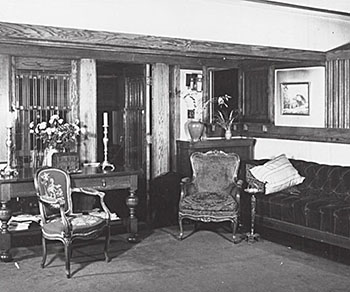 |
Trailside Museum, Page 66. Caption:
This undated
photograph shows another view of the living room of the Moe
House. In 1909, the Moe House was just one of many actual and
prospective projects Wright had attached to the contract between
himself and Herman Von Holst. Von Holst supervised the Moe House
along with various other homes, including the Frederick Robie
House. (Courtesy of Diane Schulz.) |
|
|
|
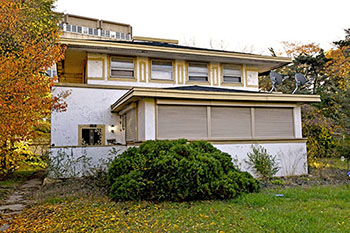 |
Date:
2023
Title:
Ingwald Moe Residence, Gary, Indiana, Exterior 2023 (1908-9 -
FLLW #0531).
Description: Set of 29 exterior
photographs of the Moe Residence. Designed by Frank Lloyd Wright
in 1905/1908-9, and most likely the plans were part of the
Evanston Model Housing Project. The exterior walls of the house
are covered in plaster and extends up to the roof line. The
sills match the light color of the stucco. The windows are
trimmed in wood, and trim is also used as a
design element between windows. Like the
Charles Brown
Residence, the front porch roof may have originally been
cantilevered. Mahony's original presentation drawing shows
a cantilevered roof. The 1911 Sanborn Fire Insurance map
shows the porch extending past the covered roof. The walls
of the porch were...
Continue...
Size:
Original 23 X 15 high res digital images.
ST#:
2023.07.1123 (1-29)
|
|
|
|
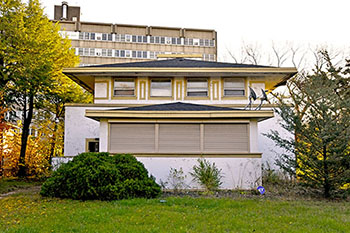 |
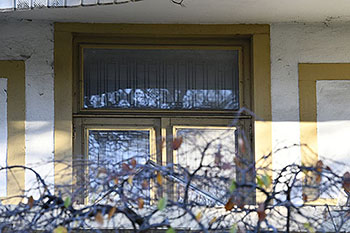 |
|
|
|
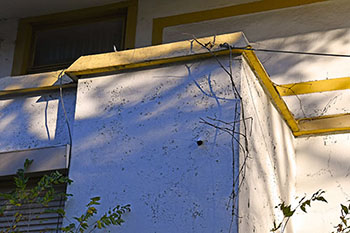 |
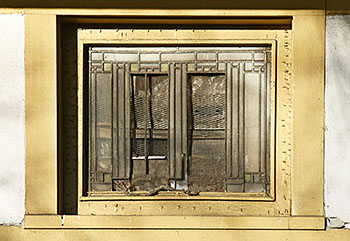 |
|
|
|
|
|
|
|
|
|
|
SANBORN FIRE INSURANCE MAPS, GARY, INDIANA (1908 & 1911) |
|
|
|
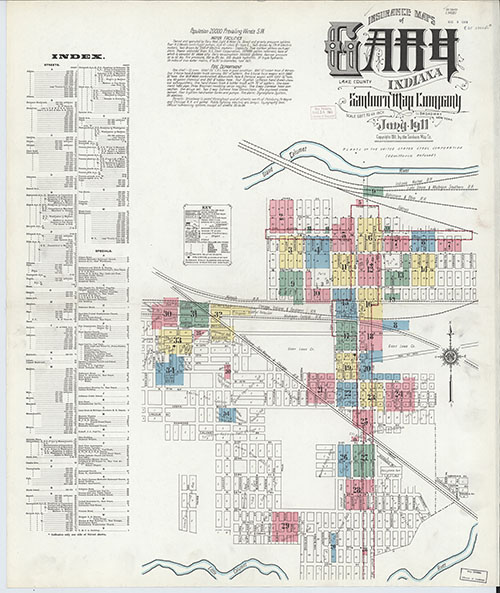 |
|
1) Ingwald Moe Residence, Gary,
Indiana, Map 1908 (1909 - FLLW #0531). The Sanborn Fire
Insurance Map for the City of Gary, Indiana, published in
December, 1908 shows a vacant lot on the Northeast corner of
7th and Van Buren Street. The Moe House was built on the
Southwest corner of Block 53. Sanborn Maps published in
January 1911 includes the footprint of a two-story house
with a one-story partially covered porch. Published
December, 1908 by the Sanborn Map Company, New York. Sheet 1
of 12 sheets. By comparing the map published in December,
1908 to the map published in January 1911, it confirms that
the Ingwald Moe house was constructed during 1909-1910. The
Inwald Moe House was designed by Frank Lloyd Wright in
1905/1908-9, and most likely plans from the Evanston Model
Housing Project. (S#0085.56.1123) |
| |
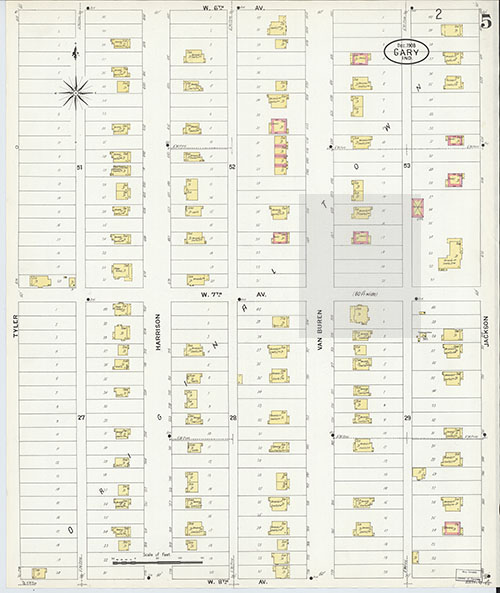 |
|
2) Ingwald Moe Residence, Gary,
Indiana, Map 1908 (1909 - FLLW #0531). The Sanborn Fire
Insurance Map for the City of Gary, Indiana, published in
December, 1908 shows a vacant lot on the Northeast corner of
7th and Van Buren Street. Note: Shaded area shows detail
below in "2B." The Moe House was built on the Southwest
corner of Block 53. Sanborn Maps published in January 1911
includes the footprint of a two-story house with a one-story
partially covered porch. Published December, 1908 by the
Sanborn Map Company, New York. Sheet 5 of 12 sheets. By
comparing the map published in December, 1908 to the map
published in January 1911, it confirms that the Ingwald Moe
house was constructed during 1909-1910. The Inwald Moe House
was designed by Frank Lloyd Wright in 1905/1908-9, and most
likely plans from the Evanston Model Housing Project. (S#0085.57.1123) |
| |
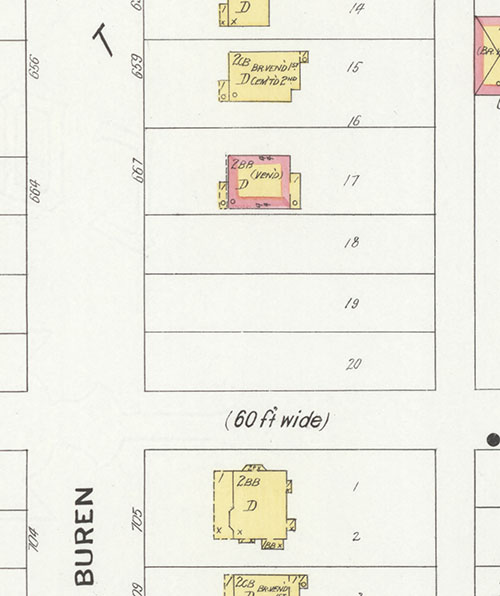 |
|
2B) Detail of the Ingwald Moe
Residence, Gary, Indiana, Map 1908 (1909 - FLLW #0531).
Note: Detail is of shaded area above in "2." The Sanborn
Fire Insurance Map for the City of Gary, Indiana, published
in December, 1908 shows a vacant lot on the Northeast corner
of 7th and Van Buren Street. |
|
|
|
 |
|
3) Ingwald Moe Residence, Gary,
Indiana, Map 1911 (1909 - FLLW #0531). The Sanborn Fire
Insurance Map for the City of Gary, Indiana, published in
January, 1911 shows a house on the Northeast corner of 7th
and Van Buren Street. The Moe House was built on the
Southwest corner of Block 53. Sanborn Maps published in
January 1911 includes the footprint of a two-story house
with a one-story partially covered porch. The roof was slate
or tin and indicates framed construction, plastered finish.
A one-story plastered Auto House was built on the Northeast
corner of the lot. The property was a corner lot that
combined three lots. Published Janury, 1911 by the Sanborn
Map Company, New York. Sheet 1 of 34 sheets. By comparing
the map published in December, 1908 to the map published in
January 1911, it confirms that the Ingwald Moe house was
constructed during 1909-1910. The Inwald Moe House was
designed by Frank Lloyd Wright in 1905/1908-9, and most
likely plans from the Evanston Model Housing Project. (S#0104.40.1123) |
|
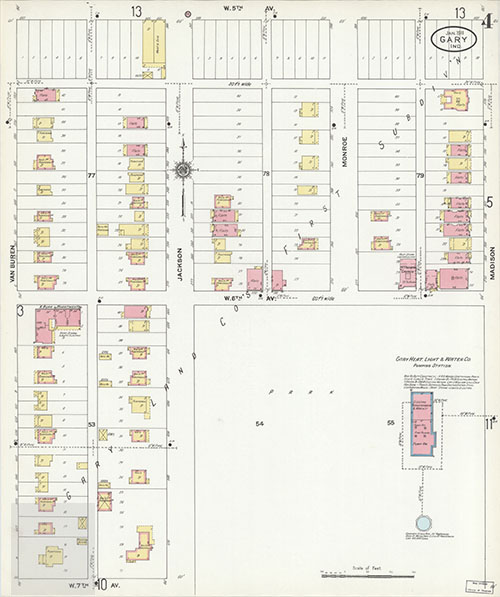 |
|
4) Ingwald Moe Residence, Gary,
Indiana, Map 1911 (1909 - FLLW #0531). The Sanborn Fire
Insurance Map for the City of Gary, Indiana, published in
January, 1911 shows a house on the Northeast corner of 7th
and Van Buren Street. Note: Shaded area shows detail below
in "4B." The Moe House was built on the Southwest corner of
Block 53. Sanborn Maps published in January 1911 includes
the footprint of a two-story house with a one-story
partially covered porch. The roof was slate or tin and
indicates framed construction, plastered finish. A one-story
plastered Auto House was built on the Northeast corner of
the lot. The property was a corner lot that combined three
lots. Published Janury, 1911 by the Sanborn Map Company, New
York. Sheet 4 of 34 sheets. By comparing the map published
in December, 1908 to the map published in January 1911, it
confirms that the Ingwald Moe house was constructed during
1909-1910. The Inwald Moe House was designed by Frank Lloyd
Wright in 1905/1908-9, and most likely plans from the
Evanston Model Housing Project. (S#0104.41.1123) |
|
 |
|
4B) Detail
of the Ingwald Moe Residence, Gary, Indiana, Map 1911 (1909
- FLLW #0531). Note: Detail is of shaded area above in "4."
The Sanborn Fire Insurance Map for the City of Gary,
Indiana, published in January, 1911 shows a house on the
Northeast corner of 7th and Van Buren Street. The Moe House
was built on the Southwest corner of Block 53. Sanborn Maps
published in January 1911 includes the footprint of a
two-story house with a one-story partially covered porch.
The roof was slate or tin and indicates framed construction,
plastered finish. A one-story plastered Auto House was built
on the Northeast corner of the lot. The property was a
corner lot that combined three lots.
|
|
|
|
|
|
|
|
|
|
INGWALD MOE PRESENTATION DRAWING (1909) |
|
|
|
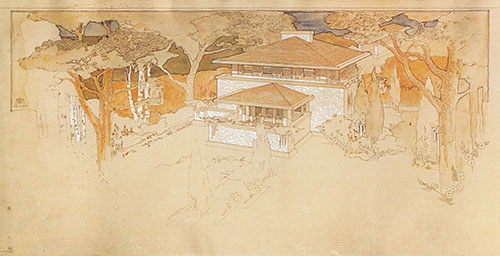 |
1) Ingwald Moe Residence, Gary, Indiana,
Perspective Drawing 1909 (1909 - FLLW #0531). Perspective
presentation drawing of the Moe Residence by Marion Mahony.
Designed by Frank Lloyd Wright in 1905/1908-9, and most likely
plans from the Evanston Model Housing Project. The exterior
walls of the house are covered in plaster and extends up to the
roof line. When this drawing was rediscovered, it was initially
credited to be the Charles Brown House because of the
similarity. It was nearly a complete match. Christopher Meyers
writes: “In the summer of 1996, I had the pleasure to confirm a
perspective drawing from the business portfolio of Marion Mahony
as the Moe residence... The drawing was originally accredited to
be the Charles Brown House. Mahony's perspective denotes a
stucco structure on a large corner lot. The Charles Brown House
is not on a corner lot rather it is located mid-block and
possesses a wooden board and batten first floor. Rather Mahony's
rendering illustrates the Moe residence, on the corner of 7th
and Van Buren, possessing a hipped roof, broad projecting eaves,
inset banding, double hung art glass windows, a front veranda
with a cantilevered roof, and as being amply landscaped...”
Christopher Meyers continues, “669 Van Buren is a precise
realization of what Frank LLoyd Wright originally designed for
the 1905 Charles Brown residence, located in Evanston, Illinois.
The Moe and Brown houses are identical, both having matching
scale, massing, and floor layouts. The Moe House differs in that
its first floor possesses an exterior stucco application in
comparison to the Brown House having wooden board and batten
clapboard.” We might add that even the art glass windows and
doors match the Brown Residence designed by Frank Lloyd Wright.
Marion Mahony’s monogram can be seen on the far left. (S#0086.34.1123) |
| |
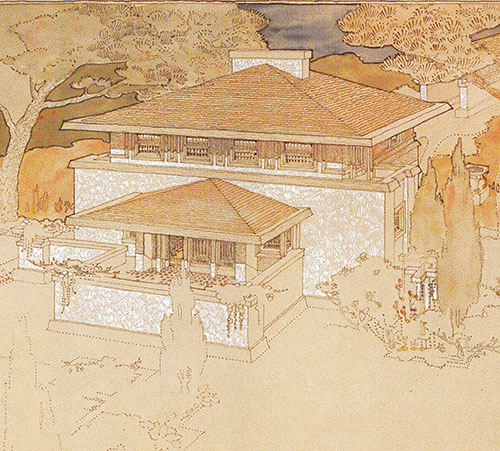 |
|
1B) Detail of the Ingwald Moe Residence Perspective Drawing 1909 (1909 - FLLW #0531).
Perspective presentation drawing of the Moe Residence by
Marion Mahony.
|
| |
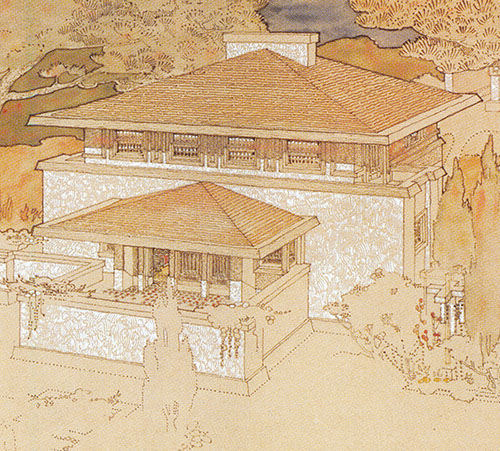 |
|
1C) Detail of the Ingwald Moe Residence Perspective Drawing 1909 (1909 - FLLW #0531).
Perspective presentation drawing of the Moe Residence by
Marion Mahony.
|
| |
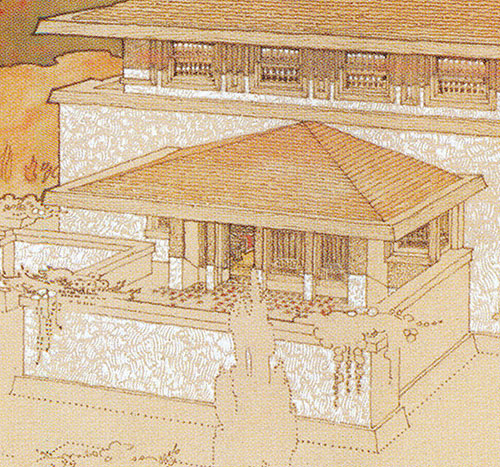 |
|
1D) Detail of the Ingwald Moe Residence Perspective Drawing 1909 (1909 - FLLW #0531).
Perspective presentation drawing of the Moe Residence by
Marion Mahony.
|
| |
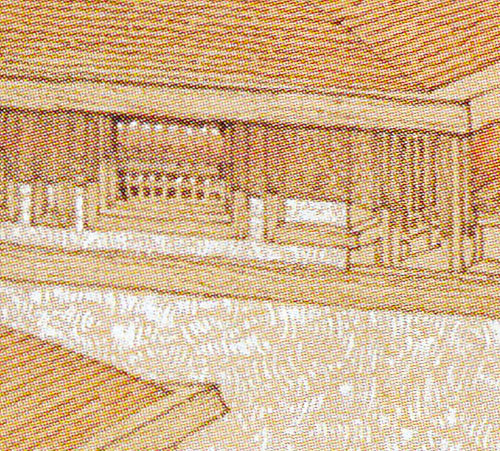 |
|
1E) Detail of the Ingwald Moe Residence Perspective Drawing 1909 (1909 - FLLW #0531).
Perspective presentation drawing of the Moe Residence by
Marion Mahony.
|
| |
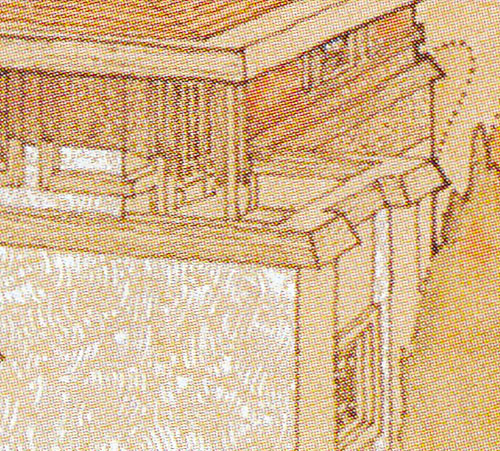 |
|
1F) Detail of the Ingwald Moe Residence Perspective Drawing 1909 (1909 - FLLW #0531).
Perspective presentation drawing of the Moe Residence by
Marion Mahony.
|
| |
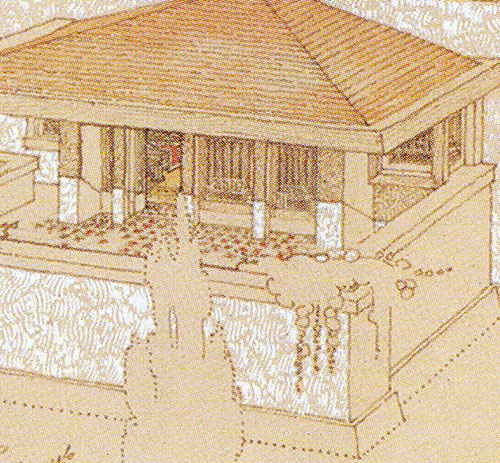 |
|
1G) Detail of the Ingwald Moe Residence Perspective Drawing 1909 (1909 - FLLW #0531).
Perspective presentation drawing of the Moe Residence by
Marion Mahony.
|
|
|
|
|
|
|
|
|
|
INGWALD MOE RESIDENCE REDISCOVERED (1996) |
|
|
|

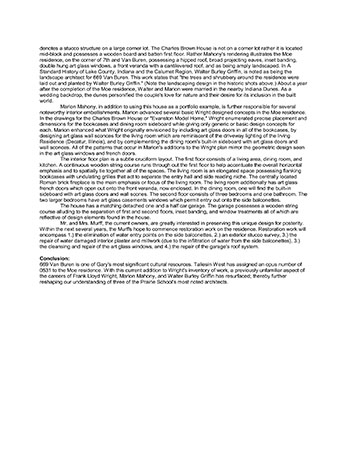 |
Christopher Meyers
Ingwald Moe House.
Gary, Indiana “America’s Magic Industrial City.”
669
Van Buren. 1996.
www.http://www.chameyer.net/frame8949.html
This
article was published on Christopher Meyers’ website. The
internet changes. We felt this article is sinificant and should
be preserved. We attempted to contact Christopher Meyers, but
were unable. Mr. Meyers, please contact us. A condensed version
of this article was published in the
Bulletin, The Quarterly Newsletter of The Frank Lloyd Wright
Building Conservancy. Volume 5, Issue 3 - Autumn 1996,
p.14-15. It includes a floor plan and seven photographs.
Introduction.
On the northeast corner of
Seventh Avenue and Van Buren Street sits a long overlooked Frank
Lloyd Wright design. 669 Van Buren, as viewed by its initial
appearance on a 1911 Sanborn Fire Insurance Map, is identified
as being constructed between 1909 and 1910. This Wright design
was sold to Mr. Ingwald Moe and built by his contracting
company, General Construction Company.
Before relocating to
Gary, Ingwald Moe ran his construction firm out of a downtown
Chicago Loop location. Moe likely moved his business to Gary,
"America's New Industrial City," to compete for a share of
growing construction jobs. Moreover, Moe selected a Wright
design for his private residence to illustrate an alternative
from prevailing architectural styles as well as to reflect his
social status as a successful contractor in both Gary and
Chicago. With the construction of 669 Van Buren, Moe initiated
what would become almost a decade long professional association
with Wright. Seven years later, in 1916, Moe became the unique
local representative for the American System-Built scheme of
housing, a Wright and Richards Company venture.
The Charles Brown and Ingwald Moe Residence: An Evolution of a
Wright Design Concept.
669 Van Buren is a precise
realization of what Frank Lloyd Wright originally designed for
the 1905 Charles Brown residence, located in Evanston, Illinois.
The Moe and Brown houses are identical, both having matching
scale, massing, and floor layouts. The Moe House differs in that
its first floor possesses an exterior stucco application in
comparison to the Brown House having wooden board and batten
clapboard. The Brown House is noted in Henry-Russell Hitchcock
's In the Nature of Materials as being the "Evanston Model
Home." From Hitchcock's citation, one can conclude that this
design was the prototype of a projected Prairie style tract
development or subdivision. Both the Brown and Moe residences
are not the first embodiments of this Wright archetype. A
forerunner to both of these designs can be seen in a Wright
study for a residential development for E.C. Waller, see plate
XLVIII (a) of Ausgefuhrte Bauten und Entwurfe von Frankl Wright.
The first design on this plate is the initial appearance of this
archetype in Wright's oeuvre. This design is characterized as
being a two-story single family residence possessing a hipped
roof with projecting eaves, front veranda, second story
balconettes, double hung windows, and a subtle cruciform layout.
For the Brown and Moe houses, Wright shortened the front
veranda, making its roof cantilevered, and rotated the main roof
90 degrees. Wright even continued to evolve this design
archetype in his designs for the Ingalls and Ziegler residences.
Design Authentication.
669 Van Buren is
an unsupervised Wright design. This house was constructed while
Wright was either preparing to leave for Europe or while there
working on theWasmuth Portfolio. The unsupervised aspect is not
uncommon seeing that other commissions such as Robie, Meyer May,
and Irving were partially or entirely completed in this manner.
In a contractual agreement dated July 7, 1911, the authorship of
the Moe residence is addressed. The legal firm of Silber,
Issacs, Silber, and Woley sent Frank Lloyd Wright and his legal
counsel, Kerr and Kerr, a final accounting of work performed by
Von Holst while running Wright's practice. In this final
accounting, housed at the Northwest Architectural Archives,
Wright is noted as receiving one half of the total commission of
work for the Moe residence. Wright was entitled, as agreed upon
in a 1909 contract between himself and Von Holst, to receive
fifty percent of a commission in instances where "Wright has
made sketches or may at Mr. Von Holst's request" or for "all new
work for which no sketches have yet been made, but for which
Wright has established precedents, or should there be time and
the clients so disposed, Mr. Wright may be called upon to make
sketches." In the case of the Moe residence, Wright received
fifty percent of the commission due to the fact that the Moe
house was literally what he originally designed for the
"Evanston Model Home" of 1905; a design precedent.
669 Van Buren: A Wright Design with Ehancements by
Marion Mahony.
Marion Mahony had worked in Wright's
office prior to 1909. She is noted for influencing Wright in
several areas, including the concept of his Home and Studio in
Oak Park, art glass window design ideology, and furniture
concepts. In 1909, she was asked by Von Holst to help run the
firm while Wright was in Europe. Marion stated in her biography,
The Magic of America, that "Mr. Von Holst asked me to join him,
so I did on definite arrangement that I should have complete
control of design. That suited him."
In the summer of 1996, I
had the pleasure to confirm a perspective drawing from the
business portfolio of Marion Mahony as the Moe residence, click
the image to the right to view a larger version, image courtesy
of Seymour Persky. The drawing was originally accredited to be
the Charles Brown House. Mahony's perspective denotes a stucco
structure on a large corner lot. The Charles Brown House is not
on a corner lot rather it is located mid-block and possesses a
wooden board and batten first floor. Rather Mahony's rendering
illustrates the Moe residence, on the corner of 7th and Van
Buren, possessing a hipped roof, broad projecting eaves, inset
banding, double hung art glass windows, a front veranda with a
cantilevered roof, and as being amply landscaped. In A Standard
History of Lake County, Indiana and the Calumet Region, Walter
Burley Griffin, is noted as being the landscape architect for
669 Van Buren. This work states that "the trees and shrubbery
around the residence were laid out and planted by Walter Burley
Griffin." (Note the landscaping design in the historic shots
above.) About a year after the completion of the Moe residence,
Walter and Marion were married in the nearby Indiana Dunes. As a
wedding backdrop, the dunes personified the couple's love for
nature and their desire for its inclusion in the built world.
Marion Mahony, in addition to using this house as a portfolio
example, is further responsible for several noteworthy interior
embellishments. Marion advanced several basic Wright designed
concepts in the Moe residence. In the drawings for the Charles
Brown House or "Evanston Model Home," Wright enumerated precise
placement and dimensions for the bookcases and dining room
sideboard while giving only generic or basic design concepts for
each. Marion enhanced what Wright originally envisioned by
including art glass doors in all of the bookcases, by designing
art glass wall sconces for the living room which are reminiscent
of the driveway lighting of the Irving Residence (Decatur,
Illinois), and by complementing the dining room's built-in
sideboard with art glass doors and wall sconces. All of the
patterns that occur in Marion's additions to the Wright plan
mirror the geometric design seen in the art glass windows and
french doors.
The interior floor plan is a subtle cruciform
layout. The first floor consists of a living area, dining room,
and kitchen. A continuous wooden string course runs through out
the first floor to help accentuate the overall horizontal
emphasis and to spatially tie together all of the spaces. The
living room is an elongated space possessing flanking bookcases
with undulating grilles that act to separate the entry hall and
side reading niche. The centrally located Roman brick fireplace
is the main emphasis or focus of the living room. The living
room additionally has art glass french doors which open out onto
the front veranda, now enclosed. In the dining room, one will
find the built-in sideboard with art glass doors and wall
scones. The second floor consists of three bedrooms and one
bathroom. The two larger bedrooms have art glass casements
windows which permit entry out onto the side balconettes.
The house has a matching detached one and a half car garage. The
garage possesses a wooden string course alluding to the
separation of first and second floors, inset banding, and window
treatments all of which are reflective of design elements found
in the house.
Mr. and
Mrs. Murff, the current owners, are greatly interested in
preserving this unique design for posterity. Within the next
several years, the Murffs hope to commence restoration work on
the residence. Restoration work will encompass 1.) the
elimination of water entry points on the side balconettes, 2.)
an exterior stucco survey, 3.) the repair of water damaged
interior plaster and millwork (due to the infiltration of water
from the side balconettes), 3.) the cleansing and repair of the
art glass windows, and 4.) the repair of the garage's roof
system.
Conclusion:
669 Van Buren is
one of Gary's most significant cultural resources. Taliesin West
has assigned an opus number of 0531 to the Moe residence. With
this current addition to Wright's inventory of work, a
previously unfamiliar aspect of the careers of Frank Lloyd
Wright, Marion Mahony, and Walter Burley Griffin has resurfaced;
thereby further reshaping our understanding of three of the
Prairie School's most noted architects. |
|
|
|
|
|
|
|
|
|
|
INGWALD MOE RESIDENCE (2023) |
|
|
|
|
Ingwald Moe Residence, Gary,
Indiana, Exterior 2023 (1908-9 - FLLW #0531). Set of 29
exterior photographs of the Moe Residence. Designed by Frank
Lloyd Wright in 1905/1908-9, and most likely the plans were
part of the Evanston Model Housing Project. The exterior
walls of the house are covered in plaster and extends up to
the roof line. The sills match the light color of the
stucco. The windows are trimmed in wood, and trim is also
used as a
design element between windows. Like the
Charles Brown
Residence, the front porch roof may have originally been
cantilevered. Mahony's original presentation drawing shows
a cantilevered roof. The 1911 Sanborn Fire Insurance map
shows the porch extending past the covered roof. The walls
of the porch were indicated as "framed partition" indicating
non-bearing walls. Today the porch is enclosed and the roof
line extends past the porch.
The Moe house was rediscovered in 1994 by historic
preservationist Christopher Meyers. Lack of documentation
places into question whether this qualifies as a Frank Lloyd
Wright design. The Frank Lloyd Wright Foundation, some
scholars and historians say yes, others say no.
Ingwald Moe was a Norwegian immigrant and contractor with
offices in Chicago. In 1897 he married Louisa Schaible of
Ann Arbor, Michigan. They had three children. In 1898 they
moved to Gary, Indiana. Moe saw an opportunity in the
expanding steel economy. He opened an office on Broadway in
Gary. According to Jane Morocco, "Moe played an important
role in developing the city of Gary. He was one of the
founders of the Gary Commercial Club and the chamber of
commerce, and also had a major role in the planning and
building of the Gary Gateway. He erected some of the
community's largest buildings, including the bathing
pavilion at Marquette Park, Gary Theater, Post-Tribune
Building, Methodist Hospital, and city hall. He was also
proprietor of Gary's first motion picture theater, located
at 766 Broadway. In 1922, under his guidance, construction
of Route 12, also known as Dunes Highway, began." Trailside
Museum: The Legend of Virginia Moe, 2015.
In 1909-10, Moe built a home at 669 Van Buren. He used his
construction company to complete the house. It is a nearly
exact realization of the Charles
A. Brown House in Evanston
(1905). The Sanborn Fire Insurance Map published in
December, 1908 shows a vacant lot. Sanborn maps published in
January 1911 includes the footprint of a two-story house
with a one-story partially covered porch. The roof was slate
or tin and indicates framed construction, plastered finish.
A one-story plastered Auto House was built on the Northeast
corner of the lot. The property was a corner lot that
combined three lots.
In 1916, Moe became the Gary representative for the
American
System-Built Houses. The Wilbur Wynant House was constructed
in 1917 at 600 Filmore Street, just a few blocks away form
Moe's house. Wynant was president of the Gary National Life
Insurance Company. By the mid-sixties the Wynant house was
abandoned and left to deteriorate. In the mid-1990s when
Christopher Meyers rediscovered the house he became
instrumental in an attempt to rescue it. In 2006, a
fire gutted the house and in 2009, it was demolished. In
2023, it is a vacant lot, no evidence a Wright house ever
existed.
On one of
the Brown Residence plans in the Frank Lloyd Wright
Archives, is a hand written note "Model Home Evanston."
Bruce Brooks Pfeiffer speculates that there may have been
plans for a housing project. Although no other plans have
been found to date that would substantiate an "Evanston
Housing Project." Henry-Russel Hitchcock also refers to the
Brown House as the Evanston Model Home,
In the Nature of
Materials, 1942. Thomas Heinz points out that there is a
similarly designed house several blocks away from the Brown
House in Evanston at 815 Lincoln Street. It is interesting
to note that in the May 10, 1902 issue of The Economist,
p.606, it was announced that a Charles A. Brown purchased 46
lots in "E.T. Paul's Addition to Evanston."
The "Evanston Housing Project" 1905, was not the first nor
last Frank Lloyd Wright planned community. To name a few:
Charles Roberts
Ridgeland Housing Project (1896 - FLLW #9608); Charles E.
Roberts City Block Plan #1 (1897 - FLLW #9705); Quadruple
Block Plan, Ladies Home Journal (1901); Charles E. Roberts
City Block Plan #2 (1903 - FLLW #0309);
Bitterroot Village (1908);
Three Houses for E.
C. Waller (1909);
American
System-Built Houses (1915);
Broadacre City (1935).
It is very conceivable Frank Lloyd Wright designed a plan
for the Evanston Housing Project (1905). Like the
Roberts/Goodrich House, one fully documented "Evanston
Housing Project" house was completed, the
Charles A. Brown House in Evanston.
Christopher Meyers writes, "669 Van Buren is a precise
realization of what Frank LLoyd Wright originally designed
for the 1905 Charles Brown residence, located in Evanston,
Illinois. The Moe and Brown houses are identical, both
having matching scale, massing, and floor layouts. The Moe
House differs in that its first floor possesses an exterior
stucco application in comparison to the Brown House having
wooden board and batten clapboard." We might add that even
the art glass windows and doors match the Brown Residence
designed by Frank Lloyd Wright.
Excerpts from Christopher Meyers' research: "669 Van Buren
is an unsupervised Wright design. This house was constructed
while Wright was either preparing to leave for Europe or
while there working on the Wasmuth Portfolio. The
unsupervised aspect is not uncommon seeing that other
commissions such as Robie, Meyer May, and Irving were
partially or entirely completed in this manner. In a
contractual agreement dated July 7, 1911, the authorship of
the Moe residence is addressed. The legal
|
|
firm of Silber, Issacs, Silber, and Woley
sent Frank Lloyd Wright and his legal counsel, Kerr and
Kerr, a final accounting of work performed by Von Holst
while running Wright's practice. In this final accounting,
housed at the Northwest Architectural Archives, Wright is
noted as receiving one half of the total commission of work
for the Moe residence. Wright was entitled, as agreed upon
in a 1909 contract between himself and Von Holst, to receive
fifty percent of a commission in instances where "Wright has
made sketches or may at Mr. Von Holst's request" or for "all
new work for which no sketches have yet been made, but for
which Wright has established precedents, or should there be
time and the clients so disposed, Mr. Wright may be called
upon to make sketches." In the case of the Moe residence,
Wright received fifty percent of the commission due to the
fact that the Moe house was literally what he originally
designed for the "Evanston Model Home" of 1905; a design
precedent."
Christopher Meyers continues: "In the summer of 1996, I had
the pleasure to confirm a perspective drawing from the
business portfolio of Marion Mahony as the Moe residence...
The drawing was originally accredited to be the Charles
Brown House. Mahony's perspective denotes a stucco structure
on a large corner lot. The Charles Brown House is not on a
corner lot rather it is located mid-block and possesses a
wooden board and batten first floor. Rather Mahony's
rendering illustrates the Moe residence, on the corner of
7th and Van Buren, possessing a hipped roof, broad
projecting eaves, inset banding, double hung art glass
windows, a front veranda with a cantilevered roof, and as
being amply landscaped..."
It is interesting to note the cantilevered roof over the
front porch in Mahony's drawing. Wright's design for the
Brown House included the cantilevered roof. What Mahony
portrays in the perspective drawing is Wright's design for a
cantilevered roof. Today, and in photographs as early as
1917, corner
columns support the roof of the Moe House. There is no
documentation to indicate whether the house was built with
or without columns supporting the roof.
Meyers continues, "Marion Mahony, in addition to using this
house as a portfolio example, is further responsible for
several noteworthy interior embellishments. Marion advanced
several basic Wright designed concepts in the Moe residence.
In the drawings for the Charles Brown House or "Evanston
Model Home," Wright enumerated precise placement and
dimensions for the bookcases and dining room sideboard while
giving only generic or basic design concepts for each.
Marion enhanced what Wright originally envisioned by
including art glass doors in all of the bookcases, by
designing art glass wall sconces for the living room which
are reminiscent of the driveway lighting of the Irving
Residence (Decatur, Illinois), and by complementing the
dining room's built-in sideboard with art glass doors and
wall sconces. All of the patterns that occur in Marion's
additions to the Wright plan mirror the geometric design
seen in the art glass windows and french doors."
Meyers continues, "The interior floor plan is a subtle
cruciform layout. The first floor consists of a living area,
dining room, and kitchen. A continuous wooden string course
runs through out the first floor to help accentuate the
overall horizontal emphasis and to spatially tie together
all of the spaces. The living room is an elongated space
possessing flanking bookcases with undulating grilles that
act to separate the entry hall and side reading niche. The
centrally located Roman brick fireplace is the main emphasis
or focus of the living room. The living room additionally
has art glass french doors which open out onto the front
veranda, now enclosed. In the dining room, one will find the
built-in sideboard with art glass doors and wall scones. The
second floor consists of three bedrooms and one bathroom.
The two larger bedrooms have art glass casements windows
which permit entry out onto the side balconettes."
"The house has a matching detached one and a half car
garage. The garage possesses a wooden string course alluding
to the separation of first and second floors, inset banding,
and window treatments all of which are reflective of design
elements found in the house."
Meyers concludes, "669 Van Buren is one of Gary's most
significant cultural resources. Taliesin West has assigned
an opus number of 0531 to the Moe residence. With this
current addition to Wright's inventory of work, a previously
unfamiliar aspect of the careers of Frank Lloyd Wright,
Marion Mahony, and Walter Burley Griffin has resurfaced;
thereby further reshaping our understanding of three of the
Prairie School's most noted architects."
Christopher Meyers made a very
compelling case. One that the Frank Lloyd Wright Foundation
and the Frank Lloyd Wright Building Conservancy adopted. In
1996, the
Bulletin, The Quarterly Newsletter of The Frank
Lloyd Wright Building Conservancy,
Autumn 1996, published Meyer's findings.
It is interesting to note that the built-in bookshelves in
the Charles Brown House did not originally have art glass
doors. When the present owner of the Brown house began
restoring the house around 2000, art glass doors were added
to the built-in bookshelves in the living room.
Set of 29 exterior photographs of the Ingwald Moe Residence
photographed by Douglas M. Steiner on October 30, 2023. Our
intent is to record the details that create the totality of
the design, creating a complete picture, as-well-as the
present condition of the home. In an effort to expedite
adding these photographs to this website, we have dispensed
with a description for each photograph. Original 23 X 15
high res digital images.
|
|
|
|
|
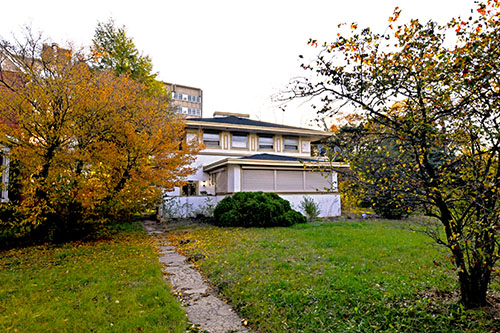 |
| 1) Ingwald Moe Residence, Gary,
Indiana, Exterior 2023 (1909 - FLLW #0531). 23 x 15 high res
digital image, photographed by Douglas M. Steiner on October
30, 2023. Copyright 2023, Douglas M. Steiner.
(ST#2023.07.1123-1) |
| |
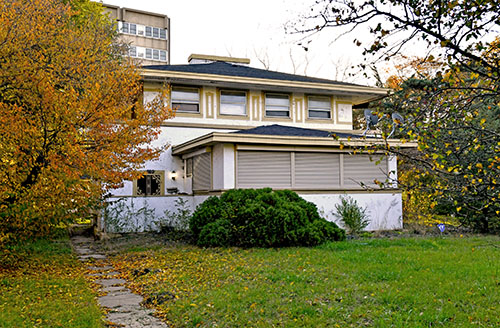 |
| 2) Ingwald Moe Residence, Gary,
Indiana, Exterior 2023 (1909 - FLLW #0531). 23 x 15 high res
digital image, photographed by Douglas M. Steiner on October
30, 2023. Copyright 2023, Douglas M. Steiner.
(ST#2023.07.1123-2) |
| |
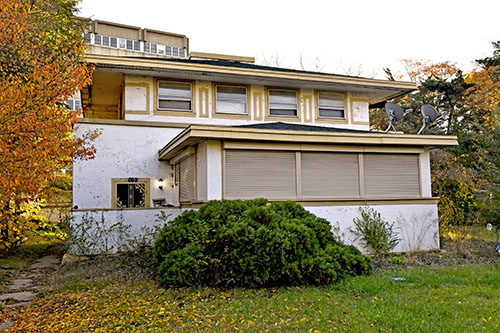 |
| 3) Ingwald Moe Residence, Gary,
Indiana, Exterior 2023 (1909 - FLLW #0531). 23 x 15 high res
digital image, photographed by Douglas M. Steiner on October
30, 2023. Copyright 2023, Douglas M. Steiner.
(ST#2023.07.1123-3) |
| |
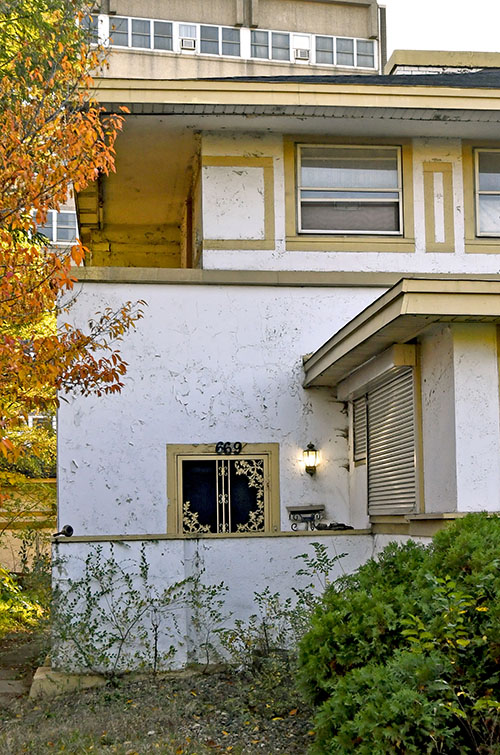 |
| 4) Ingwald Moe Residence, Gary,
Indiana, Exterior 2023 (1909 - FLLW #0531). 23 x 15 high res
digital image, photographed by Douglas M. Steiner on October
30, 2023. Copyright 2023, Douglas M. Steiner.
(ST#2023.07.1123-4) |
| |
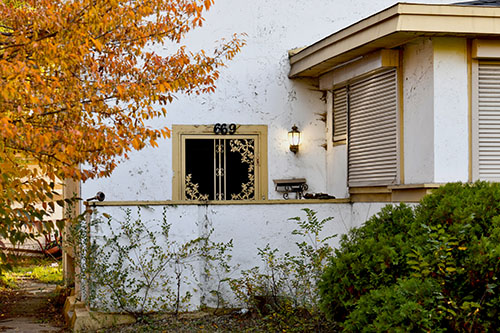 |
| 5) Ingwald Moe Residence, Gary,
Indiana, Exterior 2023 (1909 - FLLW #0531). 23 x 15 high res
digital image, photographed by Douglas M. Steiner on October
30, 2023. Copyright 2023, Douglas M. Steiner.
(ST#2023.07.1123-5) |
| |
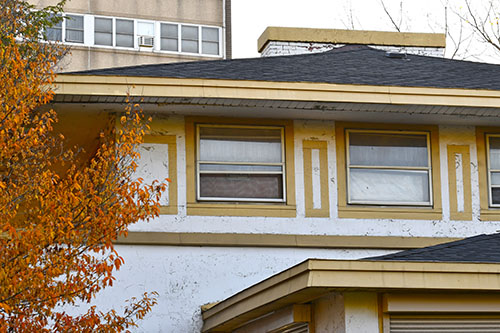 |
| 6) Ingwald Moe Residence, Gary,
Indiana, Exterior 2023 (1909 - FLLW #0531). 23 x 15 high res
digital image, photographed by Douglas M. Steiner on October
30, 2023. Copyright 2023, Douglas M. Steiner.
(ST#2023.07.1123-6) |
| |
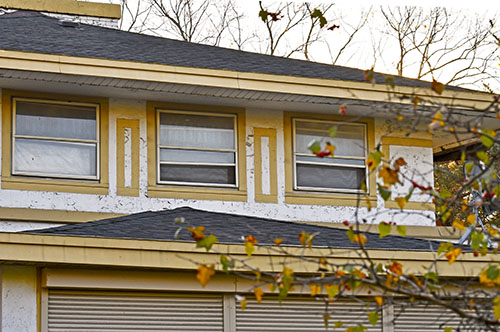 |
| 7) Ingwald Moe Residence, Gary,
Indiana, Exterior 2023 (1909 - FLLW #0531). 23 x 15 high res
digital image, photographed by Douglas M. Steiner on October
30, 2023. Copyright 2023, Douglas M. Steiner.
(ST#2023.07.1123-7) |
| |
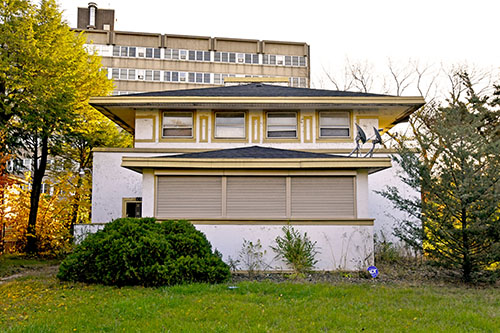 |
| 8) Ingwald Moe Residence, Gary,
Indiana, Exterior 2023 (1909 - FLLW #0531). 23 x 15 high res
digital image, photographed by Douglas M. Steiner on October
30, 2023. Copyright 2023, Douglas M. Steiner.
(ST#2023.07.1123-8) |
| |
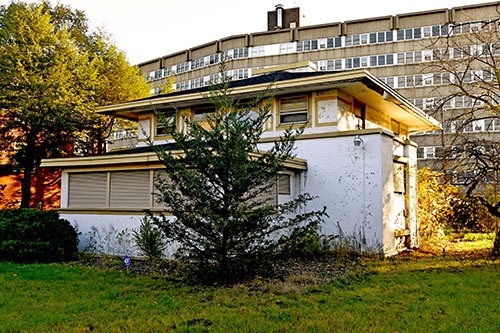 |
| 9) Ingwald Moe Residence, Gary,
Indiana, Exterior 2023 (1909 - FLLW #0531). 23 x 15 high res
digital image, photographed by Douglas M. Steiner on October
30, 2023. Copyright 2023, Douglas M. Steiner.
(ST#2023.07.1123-9) |
| |
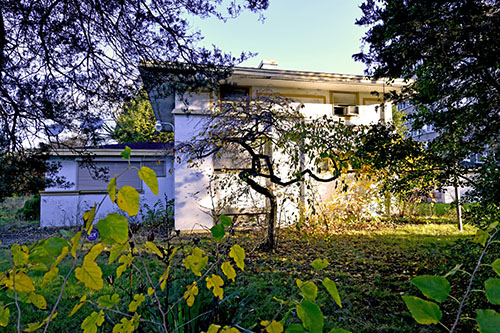 |
| 10) Ingwald Moe Residence, Gary,
Indiana, Exterior 2023 (1909 - FLLW #0531). 23 x 15 high res
digital image, photographed by Douglas M. Steiner on October
30, 2023. Copyright 2023, Douglas M. Steiner.
(ST#2023.07.1123-10) |
| |
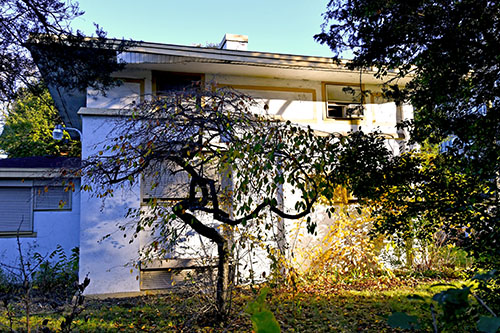 |
| 11) Ingwald Moe Residence, Gary,
Indiana, Exterior 2023 (1909 - FLLW #0531). 23 x 15 high res
digital image, photographed by Douglas M. Steiner on October
30, 2023. Copyright 2023, Douglas M. Steiner.
(ST#2023.07.1123-11) |
| |
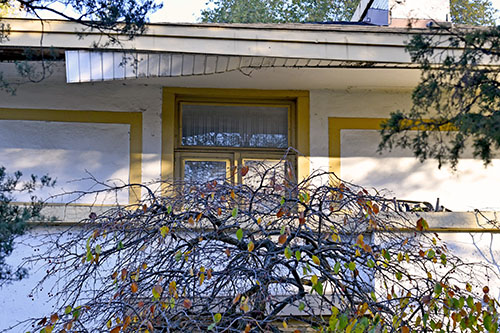 |
| 12) Ingwald Moe Residence, Gary,
Indiana, Exterior 2023 (1909 - FLLW #0531). 23 x 15 high res
digital image, photographed by Douglas M. Steiner on October
30, 2023. Copyright 2023, Douglas M. Steiner.
(ST#2023.07.1123-12) |
| |
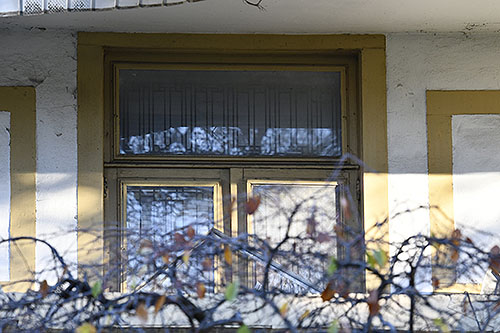 |
| 13) Ingwald Moe Residence, Gary,
Indiana, Exterior 2023 (1909 - FLLW #0531). 23 x 15 high res
digital image, photographed by Douglas M. Steiner on October
30, 2023. Copyright 2023, Douglas M. Steiner.
(ST#2023.07.1123-13) |
| |
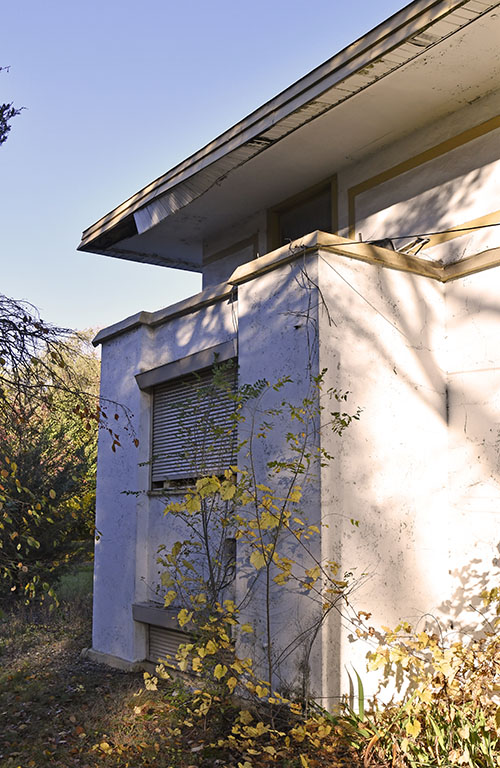 |
| 14) Ingwald Moe Residence, Gary,
Indiana, Exterior 2023 (1909 - FLLW #0531). 23 x 15 high res
digital image, photographed by Douglas M. Steiner on October
30, 2023. Copyright 2023, Douglas M. Steiner.
(ST#2023.07.1123-14) |
| |
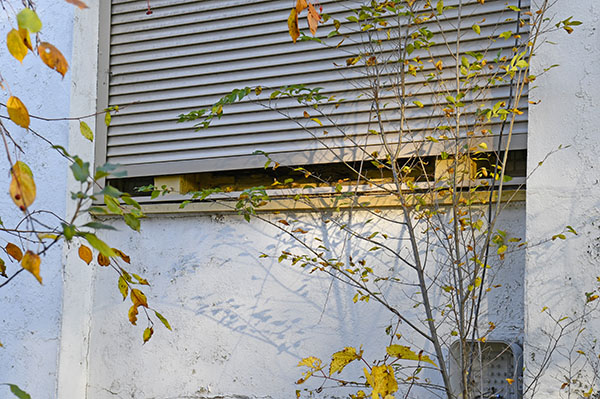 |
| 15) Ingwald Moe Residence, Gary,
Indiana, Exterior 2023 (1909 - FLLW #0531). 23 x 15 high res
digital image, photographed by Douglas M. Steiner on October
30, 2023. Copyright 2023, Douglas M. Steiner.
(ST#2023.07.1123-15) |
| |
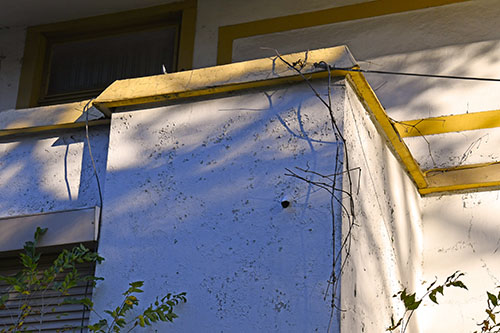 |
| 16 Ingwald Moe Residence, Gary,
Indiana, Exterior 2023 (1909 - FLLW #0531). 23 x 15 high res
digital image, photographed by Douglas M. Steiner on October
30, 2023. Copyright 2023, Douglas M. Steiner.
(ST#2023.07.1123-16) |
| |
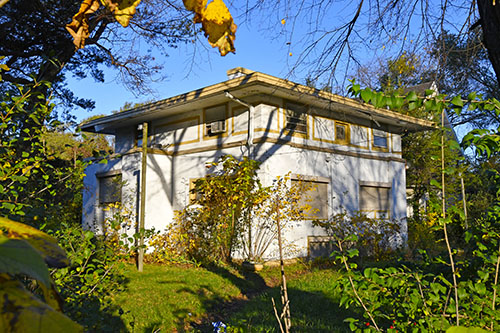 |
| 17 Ingwald Moe Residence, Gary,
Indiana, Exterior 2023 (1909 - FLLW #0531). 23 x 15 high res
digital image, photographed by Douglas M. Steiner on October
30, 2023. Copyright 2023, Douglas M. Steiner.
(ST#2023.07.1123-17) |
| |
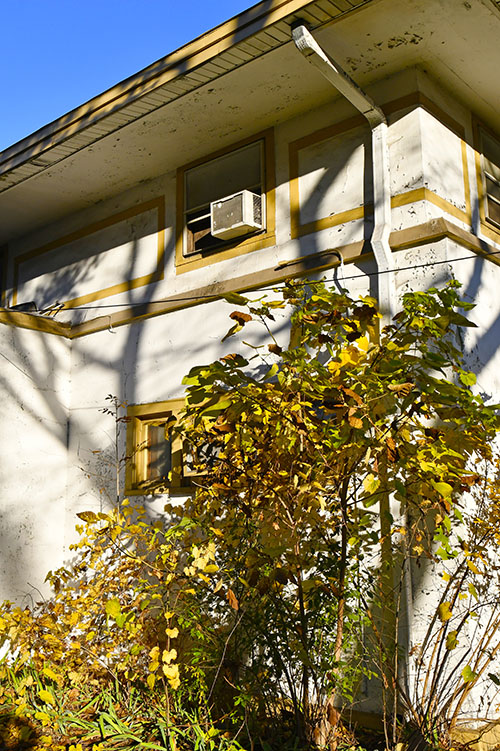 |
| 18) Ingwald Moe Residence, Gary,
Indiana, Exterior 2023 (1909 - FLLW #0531). 23 x 15 high res
digital image, photographed by Douglas M. Steiner on October
30, 2023. Copyright 2023, Douglas M. Steiner.
(ST#2023.07.1123-18) |
| |
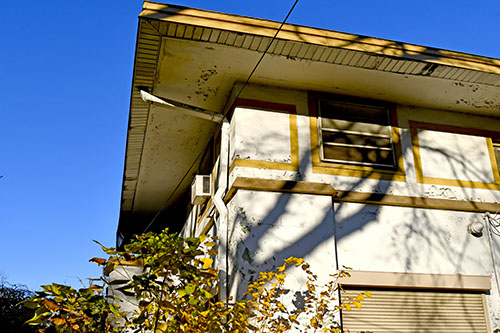 |
| 19) Ingwald Moe Residence, Gary,
Indiana, Exterior 2023 (1909 - FLLW #0531). 23 x 15 high res
digital image, photographed by Douglas M. Steiner on October
30, 2023. Copyright 2023, Douglas M. Steiner.
(ST#2023.07.1123-19) |
| |
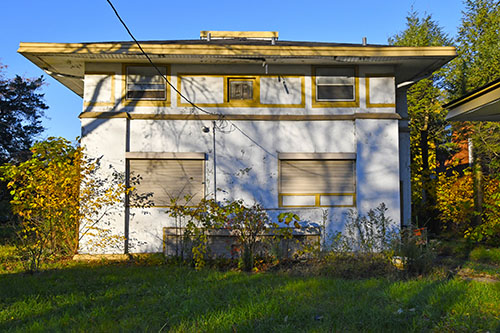 |
| 20) Ingwald Moe Residence, Gary,
Indiana, Exterior 2023 (1909 - FLLW #0531). 23 x 15 high res
digital image, photographed by Douglas M. Steiner on October
30, 2023. Copyright 2023, Douglas M. Steiner.
(ST#2023.07.1123-20) |
| |
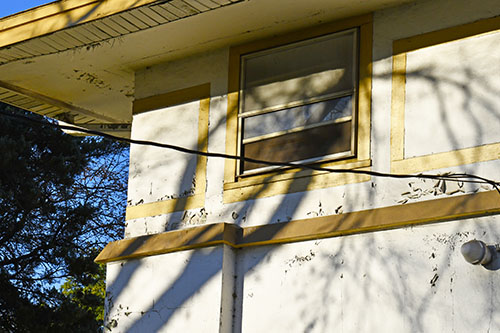 |
| 21) Ingwald Moe Residence, Gary,
Indiana, Exterior 2023 (1909 - FLLW #0531). 23 x 15 high res
digital image, photographed by Douglas M. Steiner on October
30, 2023. Copyright 2023, Douglas M. Steiner.
(ST#2023.07.1123-21) |
|
|
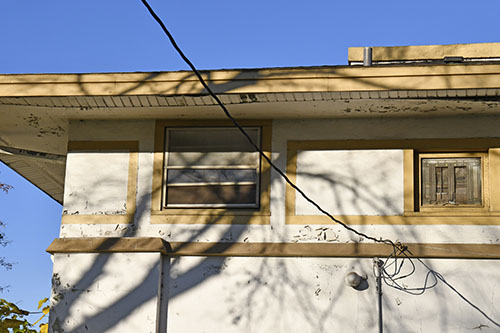 |
| 22) Ingwald Moe Residence, Gary,
Indiana, Exterior 2023 (1909 - FLLW #0531). 23 x 15 high res
digital image, photographed by Douglas M. Steiner on October
30, 2023. Copyright 2023, Douglas M. Steiner.
(ST#2023.07.1123-22) |
| |
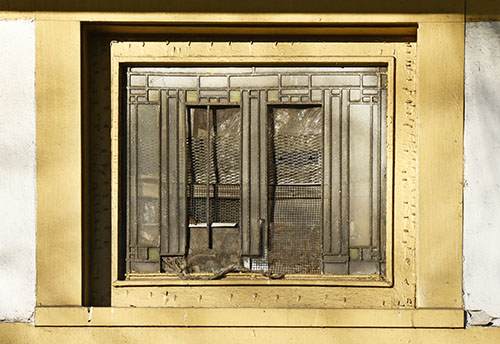 |
| 23) Ingwald Moe Residence, Gary,
Indiana, Exterior 2023 (1909 - FLLW #0531). 23 x 15 high res
digital image, photographed by Douglas M. Steiner on October
30, 2023. Copyright 2023, Douglas M. Steiner.
(ST#2023.07.1123-23) |
| |
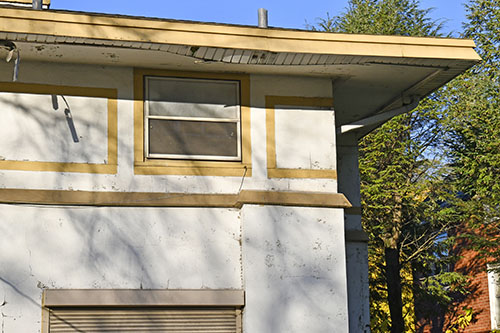 |
| 24) Ingwald Moe Residence, Gary,
Indiana, Exterior 2023 (1909 - FLLW #0531). 23 x 15 high res
digital image, photographed by Douglas M. Steiner on October
30, 2023. Copyright 2023, Douglas M. Steiner.
(ST#2023.07.1123-24) |
| |
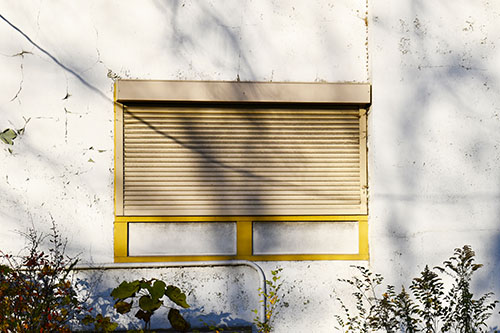 |
| 25) Ingwald Moe Residence, Gary,
Indiana, Exterior 2023 (1909 - FLLW #0531). 23 x 15 high res
digital image, photographed by Douglas M. Steiner on October
30, 2023. Copyright 2023, Douglas M. Steiner.
(ST#2023.07.1123-25) |
| |
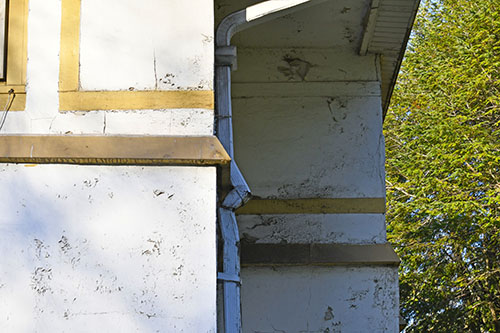 |
| 26) Ingwald Moe Residence, Gary,
Indiana, Exterior 2023 (1909 - FLLW #0531). 23 x 15 high res
digital image, photographed by Douglas M. Steiner on October
30, 2023. Copyright 2023, Douglas M. Steiner.
(ST#2023.07.1123-26) |
| |
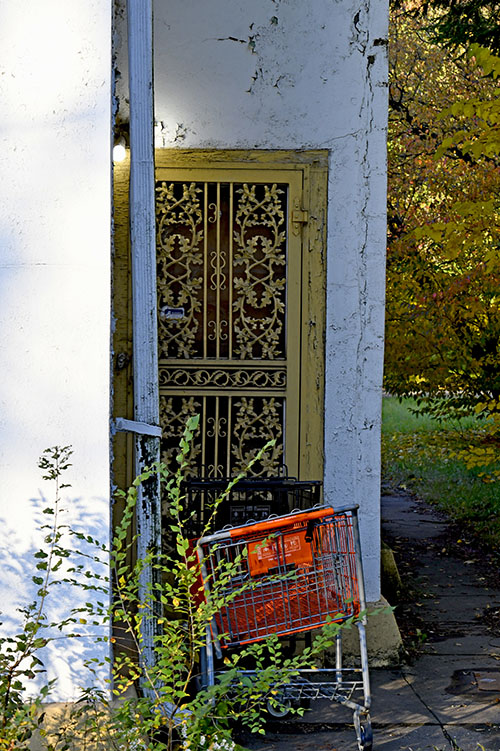 |
| 27) Ingwald Moe Residence, Gary,
Indiana, Exterior 2023 (1909 - FLLW #0531). 23 x 15 high res
digital image, photographed by Douglas M. Steiner on October
30, 2023. Copyright 2023, Douglas M. Steiner.
(ST#2023.0971123-27) |
| |
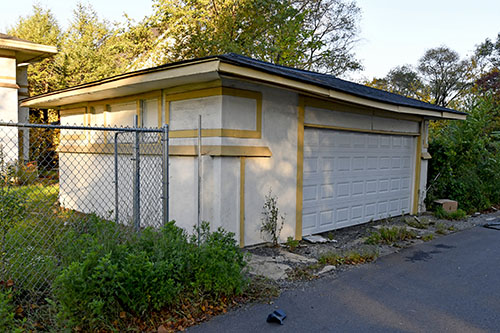 |
| 28) Ingwald Moe Residence, Gary,
Indiana, Exterior 2023 (1909 - FLLW #0531). 23 x 15 high res
digital image, photographed by Douglas M. Steiner on October
30, 2023. Copyright 2023, Douglas M. Steiner.
(ST#2023.07.1123-28) |
| |
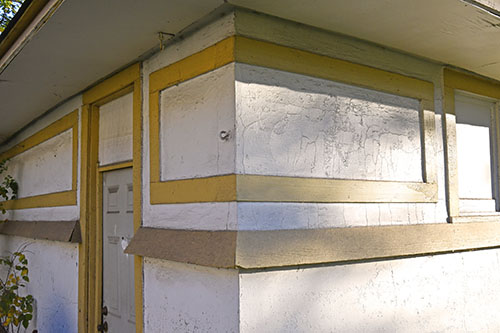 |
| 29) Ingwald Moe Residence, Gary,
Indiana, Exterior 2023 (1909 - FLLW #0531). 23 x 15 high res
digital image, photographed by Douglas M. Steiner on October
30, 2023. Copyright 2023, Douglas M. Steiner.
(ST#2023.07.1123-29) |
| |
|
|
|
|
|
|
|
|
|
|

































































